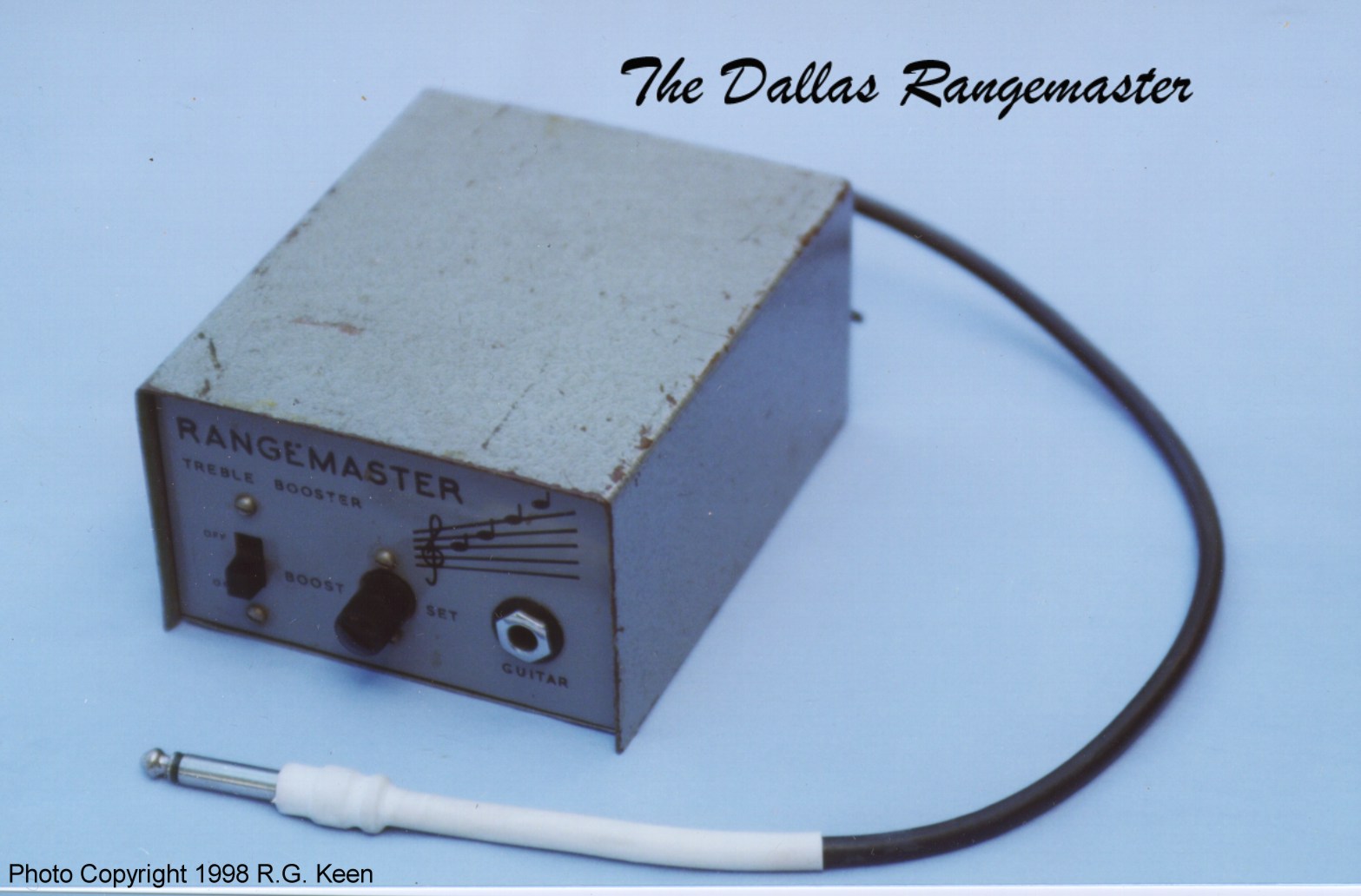Treble Booster e Pedaliere
Olè!
Molti non sanno che Brian usa davvero "pochi" effetti per il suo sound unico.
Il set-up minimo che usa da sempre Brian è il solito da moltissimi anni.
Questo è il set-up classico:
Delay1(800ms) -> Vox AC30TB
/
RedSpecial-->TrebleBooster-->-Pulito -> Vox AC30TB
\
Delay2(1600ms)-> Vox AC30TB
Il treble booster è un effetto che esalta le armonie, aumenta i bassi e il sustain della Red Special.
Brian ne ha usati davvero parecchi nella sua carriera.
Senza dubbio il primo fu il Dallas Range Master, il più famoso tra tutti i treble booster.
Usato anche da Eric Clapton... all'interno di questo effetto c'è il famoso transistor al germanio OC44 difficilissimo da reperire, ma una dei più copiati.

Di qui ha sempre usato questo effetto fino all'autunno del 1975, quando fu perso durante il tour di quell'anno da un roodies.
Siccome "The show must go on" Harold May (il papà di Brian) pensò bene di costruire al proprio figlio lo stesso effetto con qualche modifica.
L'effetto è stato riprodotto da qualche anno da Fryer e ribattezzato "RingMaster", difatti Brian conservò lo schema elettrico e lo ripropose a Greg.
L'effetto del papà fu usato fino al 1978/79 quando Pete Cornish costruì per brian una serie di Treble Booster, da qui nasce una pedaliera molto "vintage":

Nella sua pedaliera vi è anche il Foxx Phase, un altro effetto usato da brian:

Negli anni 80 Pete Cornish iniziò ad avere successo e iniziò a proporre e costruire pedaliere come si deve a Brian.
Di qui nasce un nuovo TrebleBooster (di qui TB) il "Fireplace".
Iniziò a costruire anche apparati per l'alimentazione dei Vox, e anche qualche effeto per John.
Router:

Alimentazione:

Equalizzatori per John:

E nell'86 creò due pedaliere per Brian....
La pedaliera è composta fondamentalmente da due tipologie di TB, quello "classico" e quello "plus".
Uno sempre attivo l'altro per alcuni pezzi suonati...
Ecco le pedaliere del'86:


Router + Pedaliera:

Nel '98 c'è l'era "Fryer", questi sono alcuni schemi per l'amplificazione, ricordo che May ha sempre usato il canale "clean" dei Vox:


Greg ridisegnò tutti i pedali di Brian.
Il TB classico, il Plus, il RangeMaster del papà, e anche il Deacy Amp!
Tra le varie modifiche Brian gli ciese espressamente di aumetanre il guadagno dei TB così aumentando alcuni valori dei transistor fino ad un valore fissato a: 350hfe
Nei suoi TB ci sono transistor al silicio, e solo nel Mayhem c'è qualche transistor al germanio, più precisamente un AC128.
Tutti i suoi TB si rifanno a quelli di Cornish, con meno disturbi e con un costo assai elevato.
In studio, specialmente nei primi '70 ha usato parecchio il famosissimo Deacy amp, in pratica un piccolo amplificatore costruito da John Deacon per il suo basso, ma che si rivelò davvero grande per certe stravanganze di May.
La VOX ultimamente ha ricostruito un proprio Deacy che... non assomiglia tanto all'originale.
Non ha neanche un controllo il Deacy...
Deacy:

Non tutti sanno che May ha usato anche un chorus nelle sue escuzioni, più precisamente è smpre stato un BOSS CE-1.
Boss:

Ma pare che non fosse un Boss ma un Roland modificato da Pete Cornish.
Qui alcune info da parte di Pete Cornish:
------------------------ 1 ------------------------------
PETE CORNISH ROUTING SYSTEM FOR BRIAN MAY - QUEEN.
I'm sure that the following brief description of that Brian May stage system I designed and built in July 1982 will be interest to you:
from the guitar:
a) custom line driver;
b) 100ft custom guitar lead;
c) custom FX pedalboard containing:-
1) Input isolator,
2) Permanent Treble Boost,
3) Switchable Treble Boost 2,
4) Modified Phaser with foot operated speed pedal,
5) Modified Boss Chorus,
6) Outputs to remote rack unit,
7) Remote footswitches for rackunit.
d) Rack Routing Unit with feeds to 14 Vox AC30s all modified by me;
2MXR digital delays;
remote controls for 3 chorus amps;
3 amps via Delay 1;3 amps via Delay 2 and 5 clean amps.
In addition I designed and built a power voltage regulator as it was essential to provide exactly 240Vac to each amp to maintain the tone day to day.
The system was illustrated and described in the August 1986issue of the US magazine “GuitarPlayer"
Yours Sincerely,
Pete Cornish
------------------------ 2 ------------------------------
1) I designed a Line Driver to send, without losses, the signal from Brian May's guitar down the 100ft (33m) custom cable that I made. The Line Driver was situated on the guitar strap so the cable from the guitar was only 0.3m long and consequently loss free.
2) The second Treble Boost was added to allow for extra drive during certain solo passages - but please don't ask me which.
3) The Chorus was indeed a Roland CE-1 with some serious modifications added by me.
I can tell you that I did indeed fit Foxx Phasers into Brian May's pedalboards and the modifications I did are as follows:
1) As the Foxx speed control pedal was badly worn I moved the petentiometer to a Cry Baby chassis and fitted this on top of the pedalboard.
2) I replaced the Foxx bypass switch with one of our own heavy duty bypass switches which I fitted into the Cry Baby chassis.
3) I took the circuit board out of the Foxx chassis and fitted it into the pedalboard as it was too large to fit inside the Cry Baby chassis.
4) I built a 9Vdc supply also in the pedalboard to power the Foxx Phaser.
5) I did NO modifications to the audio circuitry of the Foxx.
Roland CE-1 mods involved level matching to allow the Treble Boost signal to pass through un-attenuated.
VOX AC30 mods involved upgrading the power supply to reduce the hum, removing all the tubes associated with the vibrato and the bright channel, cabinet modifications to improve the cooling air flow.
Fonti:
Starlick (caldamente consigliato)
www.geocities.co.jp/MusicStar-Guitar/1391/
www.brianmaycentral.com
www.brianmayworld.com